The aluminum casthouse is where aluminum wrought processing and shape casting begins, and there are many casthouse functions to consider. Scrap sorting, decoating of organic coatings on scrap, remelting, alloying, melt purification by refining and degassing, grain refining, melt transfer to casting station, casting by direct chill or other means, ingot heat treatment, and dross processing are key elements in aluminum casthouse operations.
In this focused patent review, these aluminum casthouse functions are covered among the inventions presented hereafter. The only process not covered is the role of optical emission spectroscopy (OES) to check on composition, which will be covered in a future patent review on aluminum QC testing methods.
Casthouse strategies mentioned here aim to reap economic benefits and raise casthouse productivity either by completely changing current systems of operation or by innovative step-by-step approaches. Examples of the former include the several patents on ultrasonic grain refining and degassing, as well a direct chill casting approach that utilizes heat release during casting to forego homogenization. Examples of the latter are novel approaches to remelting and casting as well as dross processing. As is typical of these patent reviews, the abstracts are presented in order of grant date, so scan the lot to find your topic of interest.
– Joseph C. Benedyk, Editor
US10710119 — MATERIAL SORTING USING A VISION SYSTEM — UHV Technologies, Inc. (USA) — The present disclosure relates in general to the sorting of materials, and in particular, to the sorting of pieces of materials (by composition) in a stream of materials moving along a conveyor system. A system sorts materials utilizing a vision system that implements a machine learning system in order to identify or classify each of the materials, which are then sorted into separate groups based on such an identification or classification. The material sorting system may include an x-ray fluorescence system to perform a classification of the materials in combination with the vision system, whereby the classification efforts of the vision system and x-ray fluorescence system are combined in order to classify and sort the materials. Elemental composition signature (ECS) values for exemplary aluminum alloys are shown.
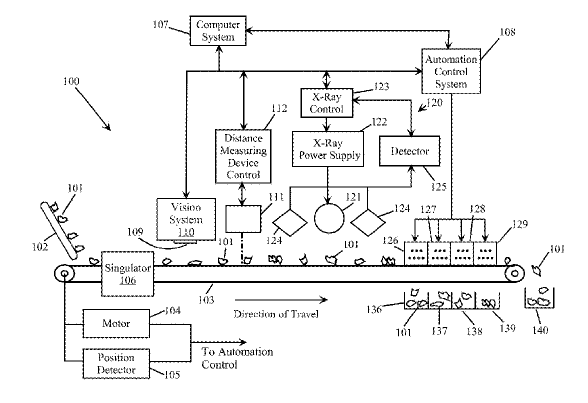
US10669609 — METHOD FOR REDUCING SALT USAGE IN ALUMINUM RECYCLING — Air Products and Chemicals, Inc. (USA) — A method of melting an aluminum charge having no more that 4% salt by mass, including during a melting phase, introducing fuel and oxidant via a burner operating at a first firing rate, the fuel and oxidant reacting to form a combustion zone above the aluminum charge, terminating the melting phase and commencing a transition phase when the aluminum charge is nearly completely molten, during the transition phase, reducing the firing rate of the burner to a second firing rate lower than the first firing rate, introducing a non-oxidizing gas at a first velocity to form a non-oxidizing zone between the combustion zone and the aluminum charge, and allowing the aluminum charge to become completely molten, and terminating the transition phase and commencing a tapping phase after the aluminum charge has become completely molten, and during the tapping phase, pouring the molten aluminum charge out of the furnace.
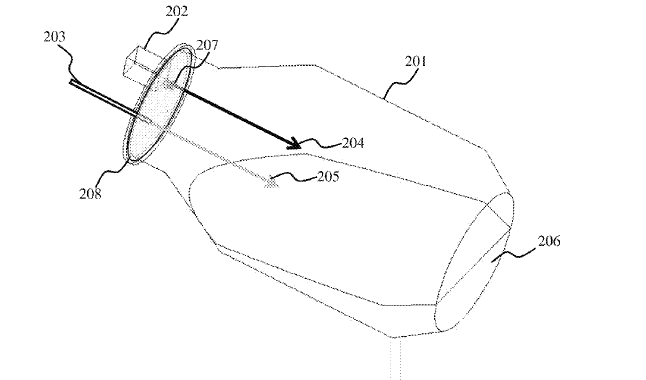
US10646919 — PROCESS AND APPARATUS FOR DIRECT CHILL CASTING — Almex USA, Inc. (USA) — An apparatus and method for casting Al-Li alloys is described. A concern with prior art teachings is that water and the Al-Li molten metal “bleed-out” or “run-out” materials come together and release hydrogen during an exothermic reaction. Even with sloped pit bottoms, minimum water levels, etc., the water and “bleed-out” or “run-out” molten metal may still come into intimate contact, enabling the reaction to occur. The instantly described apparatus and method improve the safety of DC casting of Al-Li alloys by minimizing or eliminating ingredients that must be present for an explosion to occur: a process in direct chill casting wherein molten metal is introduced into a casting mold and cooled by impingement of a liquid coolant on solidifying metal in a casting pit including a movable platen and, if an occurrence of a bleed-out or run-out is detected. the process including exhausting generated gas from the casting pit and introducing an inert gas into the casting pit, the inert gas having a density less than a density of air; reducing any flow of the liquid coolant.
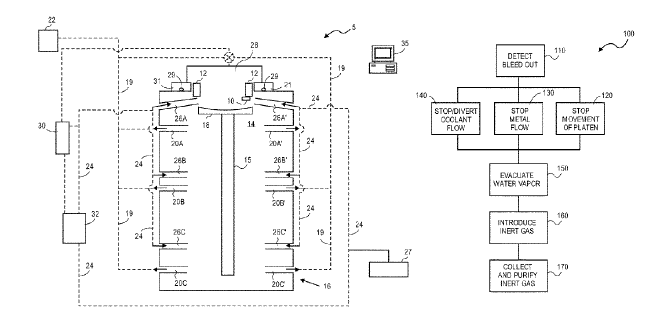
US10640846 — ULTRASONIC DEGASSING OF MOLTEN METALS — Southwire Company, LLC (USA) — Methods for degassing and for removing impurities from molten metals are disclosed. These methods can include operating an ultrasonic device in a molten metal bath and adding a purging gas into the molten metal bath in close proximity to the ultrasonic device. The present invention is directed to methods for reducing the amount of a dissolved gas (and/or various impurities) in a molten metal bath (e.g., ultrasonic degassing). In one embodiment, the method may comprise operating an ultrasonic device in the molten metal bath and introducing a purging gas into the molten metal bath in close proximity to the ultrasonic device. For example, the dissolved gas may comprise hydrogen, the molten metal bath may compr –ise aluminum or copper (including alloys thereof), and the purging gas may comprise argon and/or nitrogen. The purging gas may be added to the molten metal bath within about 50 cm (or 25 cm, or 15 cm, or 5 cm, or 2 cm) of the ultrasonic device.
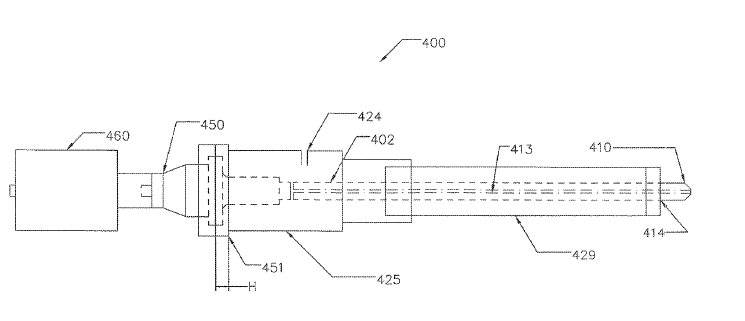
US10639707 — ULTRASONIC GRAIN REFINING AND DEGASSING PROCEDURES AND SYSTEMS FOR METAL CASTING — Southwire Company, LLC (USA) — A molten metal processing device including an assembly mounted on the casting wheel, including at least one vibrational energy source which supplies vibrational energy to molten metal cast in the casting wheel while the molten metal which comprise aluminum in the casting wheel is cooled, and a support device holding the vibrational energy source. An associated method for forming a metal product which provides molten metal into a containment structure included as a part of a casting mill, cools the molten metal in the containment structure, and couples vibrational energy into the molten metal in the containment structure.
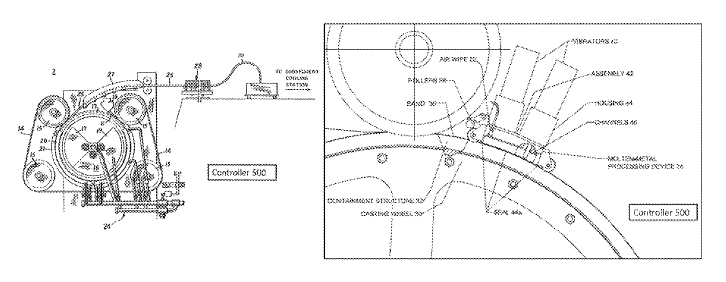
US10577675 — PROCESSING METHODS AND PROCESSING APPARATUS — Altek Europe Limited (UK) — This invention concerns improvements in and relating to processing methods and apparatus, particularly for processing aluminum slags to recover one or more useful components thereof. A method and apparatus for processing a material are provided, the material being the upper layer from a metal melting process, the material containing one or more salts, the material containing one or more metals, the salts and/or metals being recycled as a result of the method/apparatus. The method includes feeding the material to a leaching step; obtaining a leachate from the leaching step; feeding the leachate to a drying step or spray drying step; obtaining a solid from the drying step or spray drying step. Off gases from the leaching step are used to provide heat to the drying step. The drying step provides a product well suited to being turned into pellets for reuse.
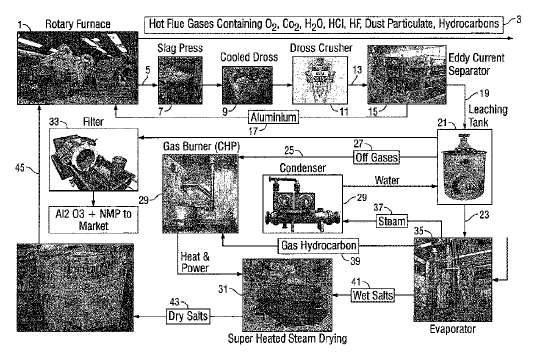
US10562097 — MOLTEN METAL TRANSFER SYSTEM AND ROTOR — Molten Metal Equipment Innovations, LLC (USA) — The invention relates to systems for transferring molten metal from one structure to another. Aspects of the invention include a transfer chamber constructed inside of or next to a vessel used to retain molten metal. The transfer chamber is in fluid communication with the vessel so molten metal from the vessel can enter the transfer chamber. A powered device, which may be inside of the transfer chamber, moves molten metal upward and out of the transfer chamber and preferably into a structure outside of the vessel, such as another vessel or a launder.
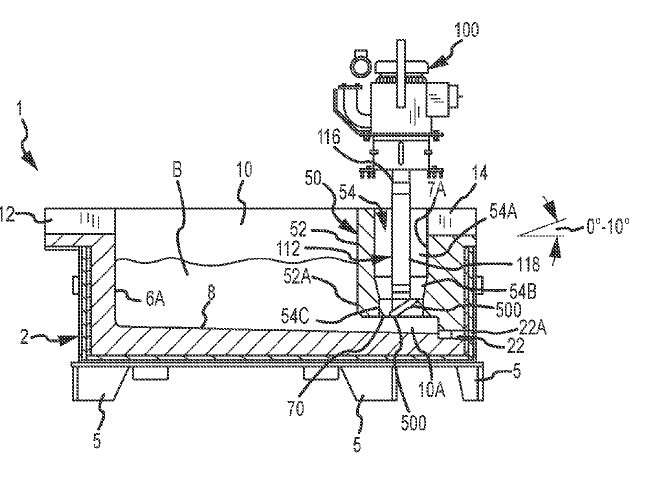
US10494699 — METHOD OF REFINING ALUMINUM ALLOY — CITIC DICASTAL CO., LTD. and Hebei University of Technology (China) — The invention provides a method of refining aluminum alloy, which is characterized in that aluminum-based nanometer quasicrystal alloy is used as an aluminum alloy refiner to refine the aluminum alloy A356.2; the aluminum-based nanometer quasicrystal alloy does not comprise Si, Fe or Cr; the aluminum-based nanometer quasicrystal alloy consists of (1) Al, (2) Mn, and (3) La and/or Ce. The refiner selected in the invention is rare earth-containing alloy which has a strong refinement ability on the aluminum alloy, and is nanometer quasicrystal; after adding the rare earth-containing alloy to melt, the element distribution of the rare earth-containing alloy is more uniform than that of traditional alloy; and nanometer quasicrystal particles substantially increase the number of heterogeneous nucleation particles and improve the grain refinement effect of the aluminum alloy. The invention has the beneficial effects that: the aluminum-based alloy used for refining the A356.2 alloy in the invention is nanometer quasicrystal alloy and has the characteristic of composition uniformity; after being added to the aluminum alloy melt, a large number of nanometer quasicrystal phases can uniformly disperse in molten aluminum as heterogeneous nucleation cores; the sizes of alpha-Al grains in the refined A356.2 alloy are significantly reduced in comparison with the sizes of grains in the aluminum alloy treated by using a traditional refiner, and the refinement effect is better. The method is relatively simple in technological process, is short in production cycle, and overcomes the disadvantages of a complicated process.

US10471506 — APPARATUS AND METHODS FOR FILTERING METALS — Alcoa Canada Co. (Canada) — The present invention relates to the filtration of aluminum metal in a molten state, and more particularly, to filtration by porous filters, such as ceramic filters. An apparatus and method for filtering molten metal, such as aluminum or an aluminum alloy includes at least one ceramic foam filter or any other type of filtration media such as porous tube or alumina balls disposed in a receptacle for the molten metal. A vibrator vibrates at least one of the filter, the receptacle or the metal and may be used to induce priming, filtering and/or drainage of the filter. The vibrator may be retrofitted to an existing filter system and may be adjustable in frequency and amplitude. The vibration may be continuous over a given period or produced in a single shock.

US10441999 — ULTRASONIC GRAIN REFINING — HANS TECH, LLC (USA) — A molten metal processing device including a molten metal containment structure for reception and transport of molten metal along a longitudinal length thereof. The device further includes a cooling unit for the containment structure including a cooling channel for passage of a liquid medium therein, and an ultrasonic probe disposed in relation to the cooling channel such that ultrasonic waves are coupled through the liquid medium in the cooling channel and through the molten metal containment structure into the molten metal.
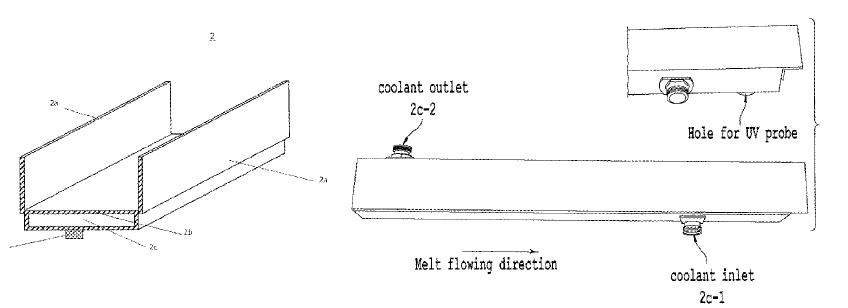
US10233515 — METAL TREATMENT STATION FOR USE WITH ULTRASONIC DEGASSING SYSTEM — Southwire Company, LLC (USA) — An apparatus may comprise a degassing system and a treatment station. The treatment station may comprise a shell, a refractory disposed in the shell, and insulation disposed between the shell and the refractory. The refractory may comprise a first plurality of slots, a second plurality of slots, and a trough. The first plurality of slots may be upstream from the degassing system and the second plurality of slots may be downstream from the degassing system. A first skim brick may be slideably disposed in a first one of the first plurality of slots and a second skim brick may be slideably disposed in a first one of the second plurality of slots. A first filter may be slideably disposed in a second one of the first plurality of slots and a second filter may be slideably disposed in a second one of the second plurality of slots.
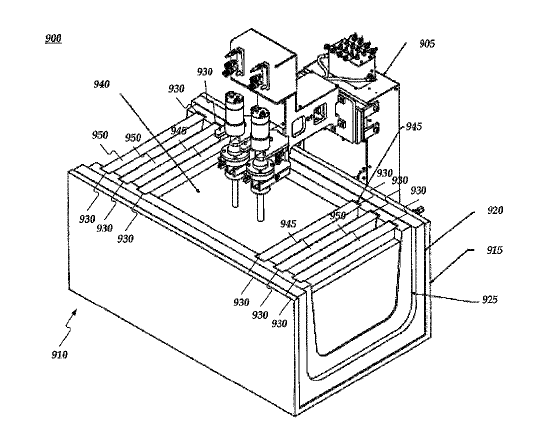
US10161682 — INTEGRATED SENSOR SYSTEM AND METHODS FOR COMBUSTION PROCESSES — Air Products and Chemicals, Inc. (USA) — An integrated sensor system for use in a furnace system including a furnace having at least one burner and two or more zones each differently affected by at least one furnace parameter regulating energy input into the furnace, including a first temperature sensor positioned to measure a first temperature in the furnace system, a second temperature sensor positioned to measure a second temperature in the furnace system; and a controller programmed to receive the first and second measured temperatures, and to adjust operation of a furnace system parameter based on a relationship between the first and second temperatures, thereby differentially regulating energy input into at least two of the zones of the furnace; wherein the relationship between the first and second temperatures is a function of one or more of a difference between the two temperatures, a ratio of the two temperatures, and a weighted average of the two temperatures.
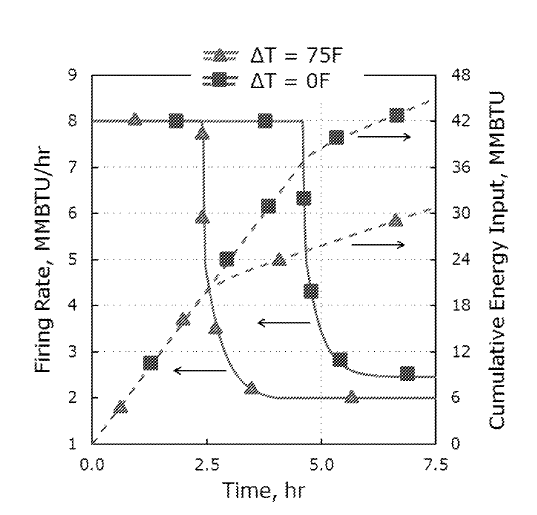
US10130980 — COOLING FACILITY AND METHOD — Constellium Neuf-Brisach (France) — A cooling method for a rolling ingot of aluminum alloy after metallurgical homogenization heat treatment of said ingot and before hot rolling, characterized in that cooling by 30 to 150°C is performed at a rate of 150 to 500°C/h, with a thermal differential of less than 40°C throughout the treated portion of the ingot is disclosed. A facility allowing use of said method and said implementation is also disclosed.
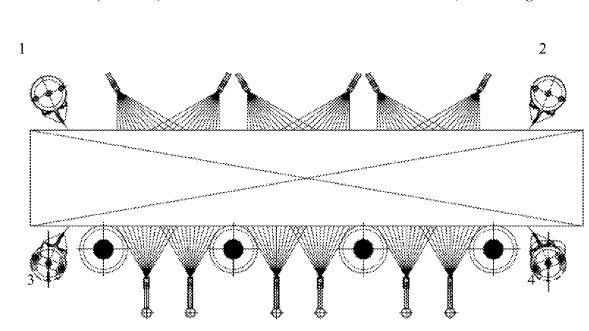
US10022786 — ULTRASONIC GRAIN REFINING — Southwire Company, LLC (USA) — A molten metal processing device including an assembly mounted on the casting wheel, including at least one vibrational energy source which supplies vibrational energy to molten metal cast in the casting wheel while the molten metal in the casting wheel is cooled, and a support device holding the vibrational energy source. An associated method for forming a metal product which provides molten metal into a containment structure included as a part of a casting mill, cools the molten metal in the containment structure, and couples vibrational energy into the molten metal in the containment structure.
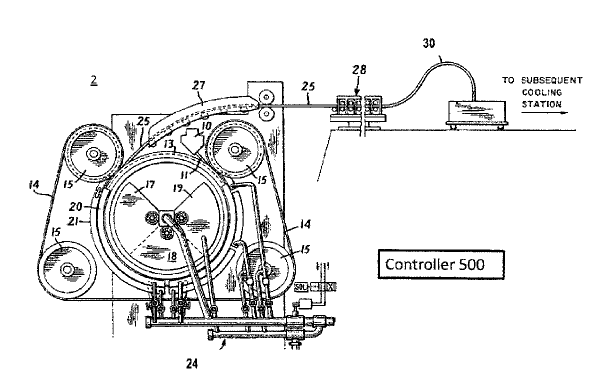
US9936541 — ALLOY MELTING AND HOLDING FURNACE — Almex USA, Inc. (USA) — An induction furnace comprising a upper furnace vessel; an induction coil positioned below the upper furnace vessel; and a melt-containing vessel positioned inside the induction coil and communicably connected to the upper furnace vessel, wherein the positioning of the melt-containing vessel inside the induction coil defines a gap between an outside surface of the melt-containing vessel and an inside surface of the induction coil. A system for direct-chill casting comprising at least one an induction furnace; at least one in-line filter operable to remove impurities in molten metal; at least one gas source coupled to a feed port associated with the gas; and at least one device for solidifying metal by casting. A method of cooling an induction furnace comprising introducing a gas into a gap between an induction coil and a melt-containing vessel positioned inside the induction coil; and circulating the gas through the gap.
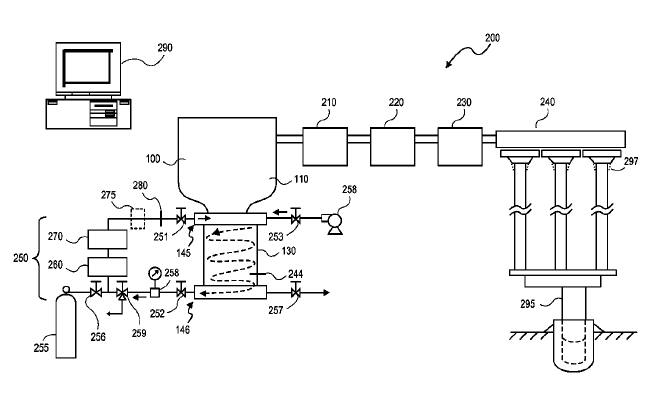
US9895744 — PROCESS AND APPARATUS FOR DIRECT CHILL CASTING — Almex USA, Inc. (USA) — An apparatus and method for casting Al-Li alloys is described. A concern with prior art teachings is that water and the Al-Li molten metal “bleed-out” or “run-out” materials come together and release hydrogen during an exothermic reaction. Even with sloped pit bottoms, minimum water levels, etc., the water and “bleed-out” or “run-out” molten metal may still come into intimate contact, enabling the reaction to occur. Casting without water, using another liquid, affects castability, quality of the cast product, is costly to implement and maintain, as well as poses environmental concerns and fire hazards. A process in direct chill casting wherein molten metal is introduced into a casting mold and cooled by impingement of a liquid coolant on solidifying metal in a casting pit including a movable platen and if an occurrence of a bleed-out or run-out is detected the process including exhausting generated gas from the casting pit; and introducing an inert gas into the casting pit, the inert gas having a density less than a density of air; reducing any flow of the liquid coolant.
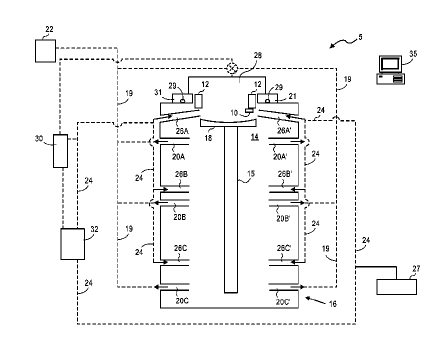
US9802245 — HOMOGENIZATION AND HEAT-TREATMENT OF CAST METALS — Novelis Inc. (USA) — A method of casting a metal ingot with a microstructure that facilitates further working, such as hot and cold rolling. The metal is cast in a direct chill casting mold, or the equivalent, that directs a spray of coolant liquid onto the outer surface of the ingot to achieve rapid cooling. The coolant is removed from the surface at a location where the emerging embryonic ingot is still not completely solid, such that the latent heat of solidification and the sensible heat of the molten core raises the temperature of the adjacent solid shell to a convergence temperature that is above a transition temperature for in-situ homogenization of the metal. A further conventional homogenization step is then not required. Desirable metallurgical changes can often be imparted in this way in a relatively short time (e.g. 10 to 30 minutes) and the procedure for achieving such a result can be incorporated into the casting operation itself, thereby avoiding the need for an additional expensive and inconvenient homogenizing step. The invention also relates to the heat-treatment of such ingots prior to hot working.
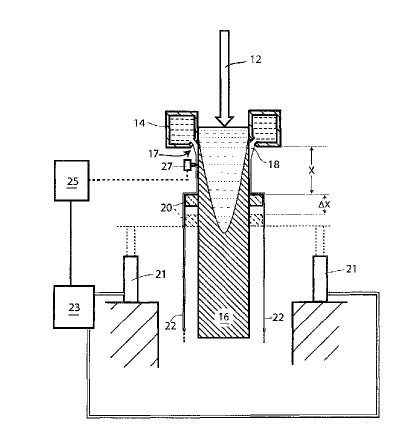
US9702022 — PROCESS AND SYSTEM FOR DE-COATING OF ALUMINUM SCRAP CONTAMINATED WITH ORGANIC COATINGS — Industrial Furnace Company (USA) — A method for removal of organic coatings from loose aluminum scrap includes passing the scrap through a Multiple Hearth Furnace operatively maintained in the range of 500°F-1600°F. Each hearth in the furnace is independently temperature controlled and held under a slightly negative pressure environment. The hearths heat the scrap such that pyrolysis of the coatings occurs within the hearth. Organic compounds liberated during this process are partially or entirely consumed within the furnace combustion products are exhausted through the top. Hydrogen fluoride contained in the products of combustion is incinerated prior to final discharge from the system and routing to additional environmental equipment for particle removal. Scrap is continuously fed into the top of the furnace and agitated and mechanically moved within each hearth toward an output of another hearth therebelow. The agitation and movement of the scrap exposes the scrap to the hearth atmosphere to assist in processing of the scrap. The discharge of the scrap in the final hearth supplies hot (250°F-900°F), clean material for the next step in the process for secondary aluminum recycling.
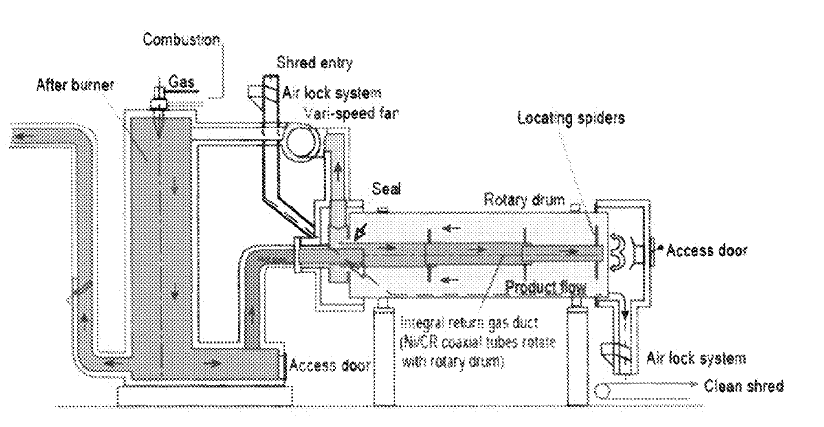
US9587291 — METHOD FOR TREATING ALUMINUM SLAGS — Aumond Fordertechnik GmbH (Germany) — In a method for treating aluminum slags (41) in the form of dross or aluminum salt slags obtained in the preparation of aluminum, the aluminum slag (41) in the melting process is brought onto a cooling conveyor (16). A first section (18) of the cooling conveyor is flushed with an inert gas and a second section (29) serves for further cooling of the aluminum slag (41) with introduction of air. In the first section (18), the aluminum slag (41) is cooled to a temperature at which the aluminum slag (41) can no longer be chemically changed by exposure to atmospheric oxygen. In the second section (29), the slag is cooled to a temperature at which the cooled aluminum slag (41) can be processed further to recover the aluminum after leaving the cooling conveyor (16).
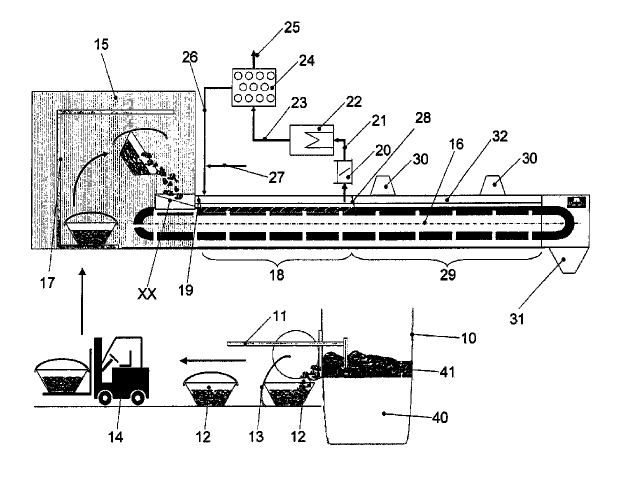
US9481031 — ULTRASONIC GRAIN REFINING — HANS TECH, LLC (USA) — The present invention is related to a method for producing metal castings with controlled grain size, a system for producing the metal castings, such as composed of an aluminum alloy, and products obtained by the metal castings. A molten metal processing device including a molten metal containment structure for reception and transport of molten metal along a longitudinal length thereof. The device further includes a cooling unit for the containment structure including a cooling channel for passage of a liquid medium therein, and an ultrasonic probe disposed in relation to the cooling channel such that ultrasonic waves are coupled through the liquid medium in the cooling channel and through the molten metal containment structure into the molten metal.
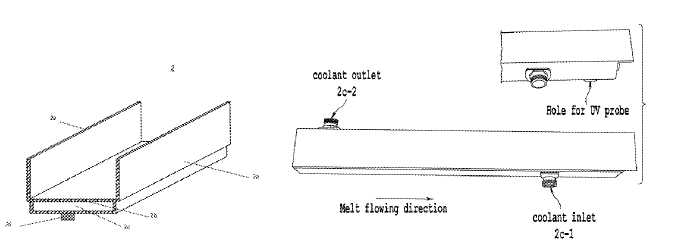
US9371573 — GRAIN REFINEMENT, ALUMINUM FOUNDRY ALLOYS — TUBITAK (Turkey) — The present invention describes an effective grain refining practice for aluminum foundry alloys. The method described herein relies on the control of the Titanium level of the alloy to be grain refined and the addition of boron once it is melted. Boron addition can be made via Al-B master alloys as well as with boron compounds such as KBF4 salt. The boron added into the melt dissolves first and then forms the AlB particles that act as potent substrates for the nucleation of aluminum once solidification process starts. The Ti concentration of the alloy must be controlled below 100 ppm for this method to offer effective grain refinement. The boron becomes ineffective when the Ti concentration in the alloy is higher.
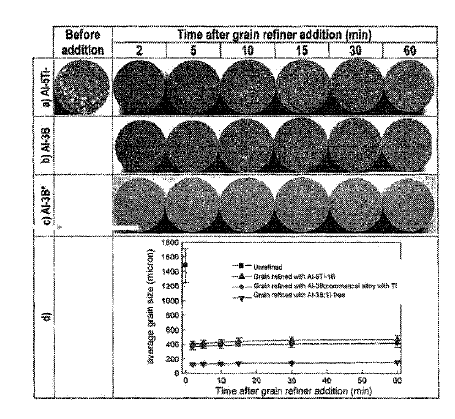
US9267214 — ALUMINUM RECOVERY PROCESS — Board of Trustees of the University of Alabama (USA) — Disclosed are processes and electrolytic cells that can be used to extract and thereby recover aluminum from aluminum-containing waste, including an aluminum dross that is suitable for disposal in a land-fill. The disclosed processes and cells use ionic liquids as an electrolyte. The disclosed cells can be adapted for either a batch process for recovery of aluminum or for a continuous process for recovery of aluminum. Further disclosed are methods for recovering aluminum metal from dross. A first embodiment relates to a batch process wherein the anode comprises aluminum-comprising dross. A further embodiment comprises a process wherein aluminum-comprising dross is continuously fed into the electrolytic cell.
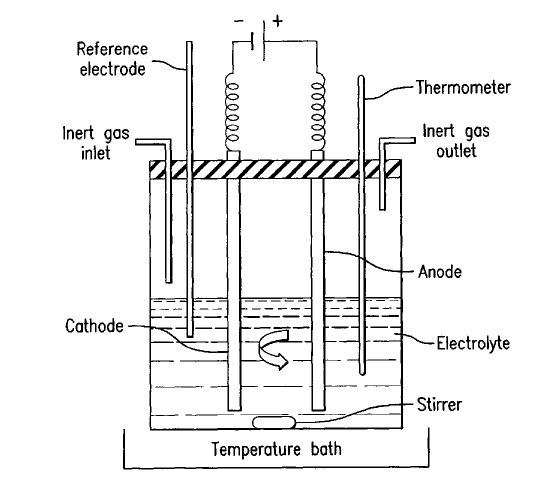
US9194029 — PROCESS FOR PRODUCING CAST ALUMINUM ALLOY MEMBER — Showa Denko K.K. (Japan) — A production method of the present invention includes a step of obtaining an aluminum alloy melt having an alloy composition containing Fe: 0.2 to 0.35 mass %, Cu: 0.05 to 0.20 mass %, Mn: 0.3 to 0.6 mass %, Mg: 1.3 to 2.0 mass %, Zn: 4.6 to 5.1 mass %, and Zr: 0.1 mass % or more, a sum of Zr and Ti being 0.2 mass % or less, the composition satisfying a relation of ([Mg mass %]-0.5x[Zn mass %]+3.8) and a relation of ([Ti mass %]/[Zr mass %]≥0.2), and the balance being aluminum and inevitable impurities, and a step of obtaining an aluminum alloy ingot having a structure that has a secondary dendritic arm spacing (DAS) of 40 µm or less and an average crystal grain diameter of 8 µm or less by continuously casting the aluminum alloy melt at a casting rate satisfying ([maximum casting rate (mm/min)]≤-1.43x[casting diameter (mm)]+500), and a step of obtaining an aluminum alloy cast member by subjecting the aluminum alloy ingot to a homogenization treatment in which the ingot is held for 1 hour at a temperature of 450 to 600°C. By this production method, an aluminum alloy cast member free from anisotropy of plastic deformation is obtained.
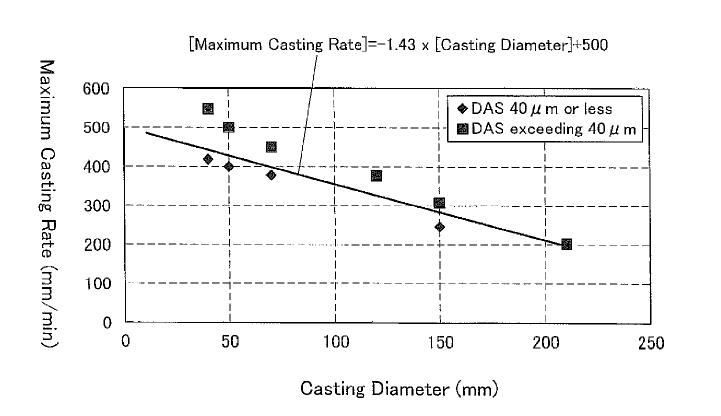
US9073115 — HOMOGENIZATION AND HEAT-TREATMENT OF CAST METALS — Novelis Inc. (USA) — A method of casting a metal ingot with a microstructure that facilitates further working, such as hot and cold rolling. The metal is cast in a direct chill casting mold, or the equivalent, that directs a spray of coolant liquid onto the outer surface of the ingot to achieve rapid cooling. The coolant is removed from the surface at a location where the emerging embryonic ingot is still not completely solid, such that the latent heat of solidification and the sensible heat of the molten core raises the temperature of the adjacent solid shell to a convergence temperature that is above a transition temperature for in-situ homogenization of the metal. A further conventional homogenization step is then not required. The invention also relates to the heat-treatment of such ingots prior to hot working.
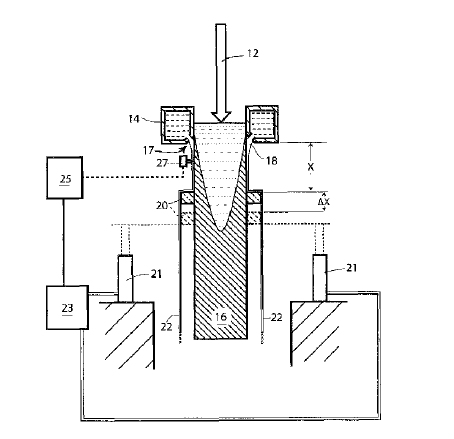
US9039850 — ALUMINUM ALLOY MATERIAL FOR FORGING — Showa Denko K.K. (Japan) — An aluminum alloy forging material of the present invention is constituted by an aluminum alloy cast product obtained by subjecting an aluminum alloy ingot having a structure in which a secondary dendritic arm spacing (DAS) is 40 µm or less and an average grain diameter of crystallized substances is 8 µm or less to homogenization treatment for holding the ingot for one hour or more under temperature conditions of 450 to 510°C, wherein the ingot is obtained by continuously casting a molten aluminum alloy having an alloy composition consisting of: Si: 0.80 to 1.15 mass %; Fe: 0.2 to 0.5 mass %; Cu: 3.8 to 5 mass %; Mn: 0.8 to 1.15 mass %; Mg: 0.5 to 0.8 mass %; Zr: 0.05 to 0.13 mass %; and Ti contained in such an amount that a sum of Ti and Zr is 0.2 mass % or less, and the balance being Al and inevitable impurities, wherein the alloy composition satisfies a Cu/Mg ratio of 8 or less, Ti is added in a form of an Al master alloy (5Ti-1B mother alloy) in which Ti and B are contained at a ratio of 5:1, and a Ti/Zr ratio satisfies 0.3 or higher.
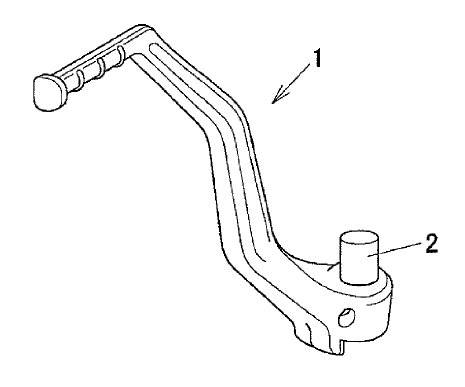
US8917754 — ALUMINUM MELTING APPARATUS — Alcoa Inc. (USA) — A method and apparatus for melting aluminum uses a dense metal salt of Rubidium, Cesium, or Strontium. The salt is melted by a stinger and then superheated by AC applied to electrodes immersed in the salt. Aluminum in contact with the salt melts and floats on the salt. In continuous scrap melting, inflows and outflows of aluminum are comparable and may be shielded by inert gas. The superheated salt may be purified and may be heated in a separate reservoir and pumped to and from another reservoir containing salt and/or metal. The salt may be used to supplement the heating of an existing furnace.
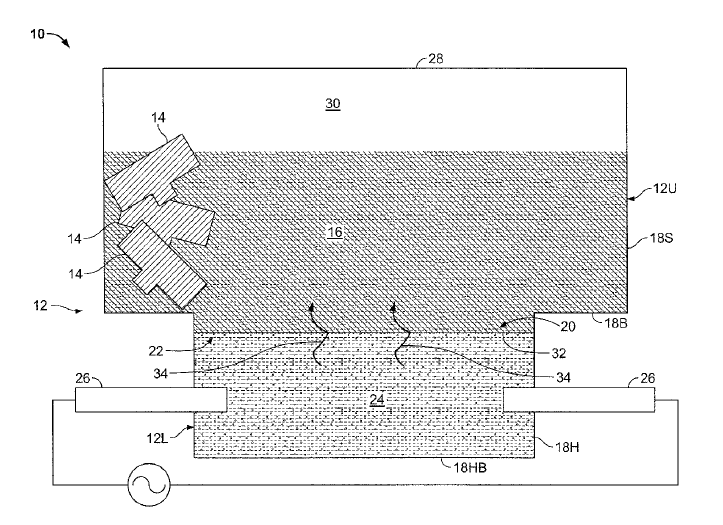
US8869993 — FILTER USED FOR FILTERING MOLTEN METAL AND PREPARATION METHOD THEREOF — Jinan Shengquan Double Surplus Ceramic Filter Co., Ltd. (China) — A filter used for filtering molten metal and a preparation method thereof are disclosed. The filter comprises open-pored porous material, binder and refractory material. The refractory material is bonded on the open-pored porous material by the binder, wherein the weight proportion of the binder is at least 50% and the weight proportion of the refractory material is not more than 50%. The filter has enhanced mechanical property and high temperature resisting property, while its preparation method is more cost-efficient than usual ones.
US8673048 — MAGNETIC SEPARATION OF IRON FROM ALUMINUM OR MAGNESIUM ALLOY MELTS — GM Global Technology Operations LLC (USA) — Iron impurities may be removed from volumes of molten aluminum or magnesium metals or alloys by applying a static magnetic field gradient to each of the molten metal volumes, or melts. The magnetic field gradient is applied to each of the melts so that separate-phase iron impurities suspended therein will move in the direction of the applied magnetic field and become concentrated in a predetermined region of the of the melts, thereby forming an iron-rich region. The remaining iron-depleted region of each of the melts can be physically separated from the as-formed iron-rich region and cast into shaped articles of manufacture or into semi-finished articles for further processing. Such articles will have a lower iron-content than the original molten metal volumes.
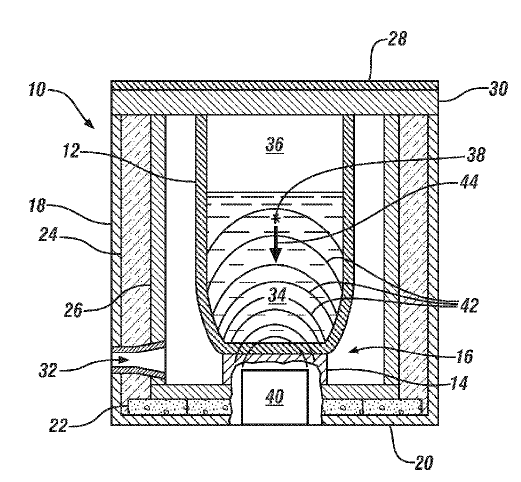
US8632621 — METHOD FOR MELTING A SOLID CHARGE — L’Air Liquide, Societe Anonyme pour l’Etude et l’Exploitation des Procedes Georges Claude (France) — A simple, compact burner achieves a more optimal melting of a solid charge followed by performance of combustion under distributed combustion conditions. The burner achieves this by fluidically bending the flame towards the solid charge during a melting phase with an actuating jet of oxidant, redirecting the flame in a direction away from the charge, and staging injection of oxidant among primary and secondary portions during a distributed combustion phase.
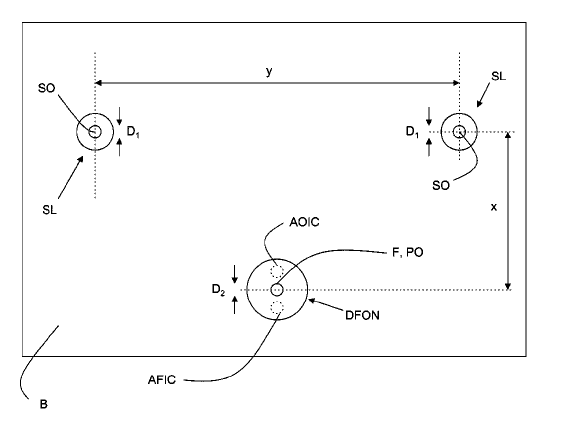
US8540910 — METHOD FOR PRODUCING A REFRACTORY MATERIAL FROM ALUMINUM RESIDUES — Atomic Energy Council–Institute of Nuclear Energy Research (Taiwan) — Disclosed is a method for making a refractory material from aluminum residues of aluminum recycling, wherein the refractory material comprises a firebrick selected from the group consisting of insulating firebricks, alumina firebricks, acid-resisting bricks, and clay firebrick. At first, the aluminum residues are mixed with an adhesive solution so that the percentage by weight of the adhesive solution is 5 wt % to 10 wt %. The mixture is granulated into grains. The grains are filled in a mold, pressed, and then removed from the mold so that the grains are turned into a green body. The green body is heated in a furnace at a range of temperature from 1100°C to 1400°C so that the grains are sintered and become a refractory material.

US8486176 — METHOD FOR FILTERING MOLTEN ALUMINUM AND MOLTEN ALUMINUM ALLOYS — Porvair PLC (UK) — A method for filtering molten aluminum and aluminum alloys. The method includes providing a reticulated foam wherein oxygen is introduced to an interior of the reticulated foam. Molten aluminum or aluminum alloy is passed through the reticulated foam wherein oxygen is maintained at a partial pressure of at least 2.51 x 10-35 atm during filtration. A particular advantage of the present invention is the ability to filter molten aluminum and aluminum alloys with reticulated filters comprising silica while mitigating reaction between the silica and components of the molten aluminum or alloy.

US8404018 — BURNER AND METHOD FOR PROCESSING OXIDIZABLE MATERIALS — Air Products and Chemicals, Inc. (USA) — Burner assembly for use in industrial heating and melting applications of material susceptible to oxidation at elevated temperatures is comprised of a flow passage of oxidant surrounded by an annular flow passage of fuel whereby the oxidant is substantially contained inside the fuel layer up to at least 5 oxidant nozzle diameters downstream of the burner outlet in order to minimize contact between the oxidant and the furnace load. An example of a suitable gaseous fuel comprises natural gas. By “metal products” here is defined as metals that are oxidizable including aluminum, iron, lead, nickel, tin, and zinc, alloys containing one or more of the foregoing, among other metals susceptible to reaction losses when heating or melting. An example of a burner design which can be employed with this invention can comprise a generally co-axial type where one of the gas streams flows through a central conduit completely or substantially completely surrounded by an annular conduit for the other gas stream. The outer annular flow comprises fuel or predominantly fuel, and the central flow comprises oxidant or predominantly oxidant.

US8313554 — METHOD FOR THE SEPARATION OF MOLTEN ALUMINUM AND SOLID INCLUSIONS — Aleris Switzerland GmbH (Switzerland) — It is an object of the present invention to provide a method for the separation of a dispersion of molten aluminum and solid inclusions, formed from a melt of aluminum containing one or more foreign chemical elements, with which the solid inclusions can be separated from the molten aluminum such that little or no molten aluminum is lost. Molten aluminum surrounding the solid inclusions is at least essentially replaced by a molten salt. This means that the solid inclusions are now incorporated in the molten salt, and are no longer part of the molten aluminum, resulting in a refinement of the aluminum.
US8302657 — CASTING PROCESS FOR ALUMINUM ALLOYS — Constellium France (France) — A casting process for an aluminum alloy containing at least about 0.1% of Mg and/or at least about 0.1% of Li in which a liquid surface of the alloy is put into contact with a dried gas including at least about 2% of oxygen by volume and with a water partial pressure lower than about 150 Pa throughout most of the solidification process is described. The process makes it possible to cast most oxidable aluminum alloys, in particular aluminum alloys containing magnesium and/or lithium, without using additives such as beryllium and/or calcium and without using expensive devices and/or gases, to obtain cast ingots generally free from surface defects and pollution, in complete safety.
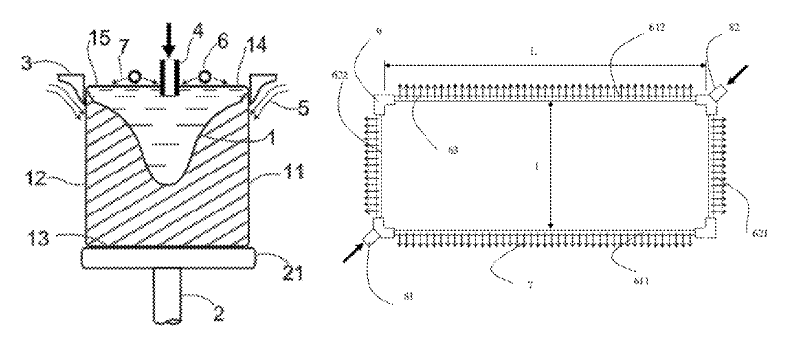
US8123853 — CALCIUM ALUMINATE CLINKER AS A REFRACTORY AGGREGATE WITH AND WITHOUT BARIUM ADDITION AND USE THEREOF — Westmoreland Advanced Materials, Inc. (USA) — The present invention provides for a refractory aggregate composition comprising an improved calcium aluminate clinker having the formula CnAx wherein C is calcium oxide and A is aluminum oxide, wherein n is an integer from about 1 to about 12, wherein x is an integer from about 1 to about 24, and wherein said clinker has from zero to less than about fifty weight percent C12A7. Analogs, derivatives, and hydrates of the improved calcium aluminate clinker are provided. A refractory composition and a sprayable refractory composition are disclosed comprising the improved calcium aluminate clinker. A method for improving the insulating character and/or penetration resistance of a liner in contact with molten aluminum in an aluminum manufacturing process or during aluminum transport is provided.
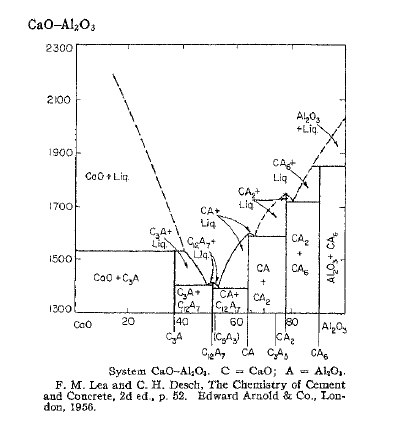
US8002872 — METHODS OF RECOVERING AND PURIFYING SECONDARY ALUMINUM — Carbontech, LLC (USA) — The invention provides efficient and effective processes for recovering metals such as aluminum, magnesium and lithium from mixed waste sources such as auto shredder residue, aluminum cans, waste particles of aluminum alloy and municipal waste. The metal-waste source is dissolved in a more noble metal solvent at a temperature at which contaminants do not dissolve, e.g., in a solvent comprising a molten metal selected from the group consisting of molten zinc, molten tin, and a combination thereof, at a temperature between 500°C and 600°C to form a liquid aluminum-solvent mixture, wherein the dissolving is conducted in a rotary furnace, drossing a precipitated metal from the liquid aluminum-solvent mixture, electrorefining aluminum from the aluminum-solvent mixture to recover aluminum metal from the aluminum-solvent mixture.
US7871478 — HOMOGENIZATION AND HEAT-TREATMENT OF CAST METALS — Novelis Inc. (USA) — A method of casting a metal ingot with a microstructure that facilitates further working, such as hot and cold rolling. The metal is cast in a direct chill casting mold, or the equivalent, that directs a spray of coolant liquid onto the outer surface of the ingot to achieve rapid cooling. The coolant is removed from the surface at a location where the emerging embryonic ingot is still not completely solid, such that the latent heat of solidification and the sensible heat of the molten core raises the temperature of the adjacent solid shell to a convergence temperature that is above a transition temperature for in-situ homogenization of the metal. A further conventional homogenization step is then not required. The invention also relates to the heat-treatment of such ingots prior to hot working.
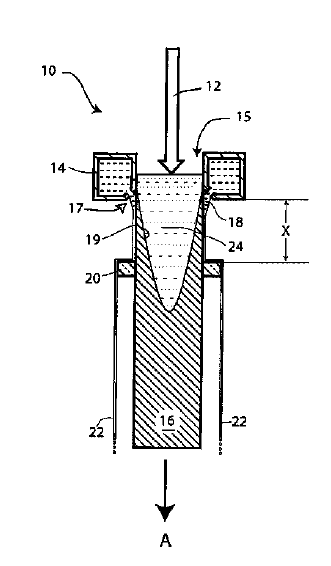
US7655067 — METHOD FOR PROCESSING ALUMINIUM IN A ROTARY OR A REVERBERATING FURNACE — L’Air Liquide-Societe Anonyme a Directoire et Conseil de Surveillande pour l’Etude et l’Exploitation des Procedes Georges Claude (France) — The invention relates to a method for processing aluminum in a furnace consisting in introducing an aluminum-containing material and possibly one or several types of salt into the furnace, melting said material by heating with the aid of at least one burner supplied with a combustive material and fuel in such a way that a molten aluminum possibly covered with a slag containing, in particular alumina and at least one salt is produced and in measuring a carbon monoxide and/or hydrogen concentration in the furnace atmosphere or in a smoke at the exit of the furnace. Oxygen content in the combustive material supplying at least one burner is greater than 10% by volume, preferably greater than 21% by volume. The inventive method also involves a final phase of reduction of the molten aluminum oxidation during which the fuel flow rate is substantially constant while the injected combustive flow rate is controlled at a value ranging from 3 to 15% by volume which is greater than a CO concentration in the furnace and/or in the smoke without control.
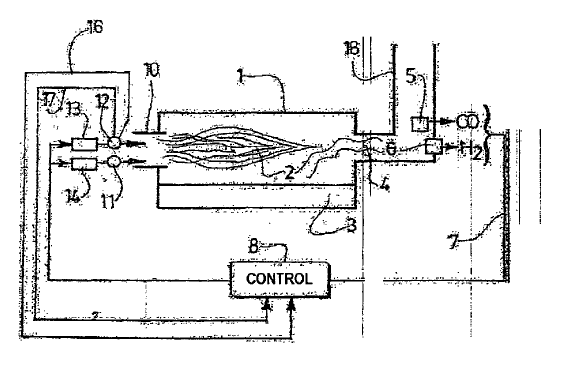
US7648558 — METHOD FOR THE TREATMENT OF ALUMINUM IN A FURNACE — L’Air Liquide-Societe Anonyme a Directoire et Conseil de Surveillande pour l’Etude et l’Exploitation des Procedes Georges Claude (France) — Methods for treating aluminum in a furnace. An aluminum charge is introduced into a furnace and melted with heat from at least one burner. The burner is supplied with at least one oxidizer and at least one fuel. The oxidizer is made up of at least 10% oxygen by volume. The concentration of a first gas is measured in the furnace atmosphere or in a flue gas exiting the furnace. The oxidation of the molten aluminum is then reduced by holding the flow rate of the oxidizer steady while varying the flow rate of the fuel, according to the concentration of a second gas in the furnace or in the flue gas exiting the furnace. The concentration of the second gas is determined by comparing the measured species concentration and the intrinsic concentration which would be present absent the aluminum charge.
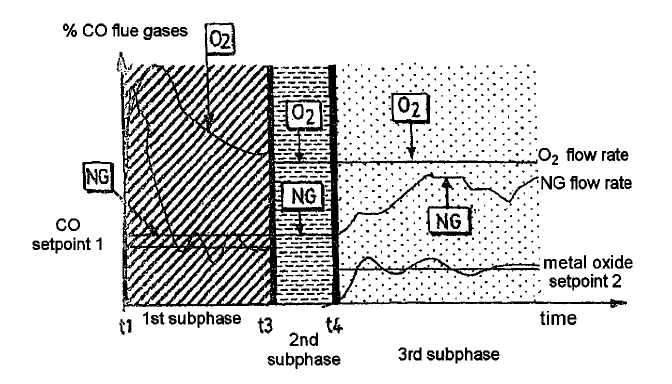
US7582252 — PLANT WITH ROTATING FURNACE FOR THE MELTING WITHOUT SALT OF ALUMINUM WITH SCREENING AND RECOVERY OF THE SLAGS — Hitech S.R.L. (Italy) — A plant is provided for the melting of primary and secondary aluminum, provided with a rotating furnace, internally equipped with a spiral element (11), that causes the melting of the aluminium not requiring use of a salty bath. The plant includes a pouring channel (13) adjacent an exit hole (4) of the rotating furnace and material from the pouring channel enters the spherical store basin (16) positioned below if, the spherical store being equipped with a rotating joint (17) having a common inclination with the pouring channel (13) so that what is obtained is the direct and continuous flow of the fused metal in the spherical store without interruption of the process of melting. The plant is also equipped with an automatic and continuous system of selection and recovery of the slag of fusion, integrated in the same plant, and a double system of canalization of the gases that allows cleaning of the pollutant agents and energy conservation in the melting furnace.
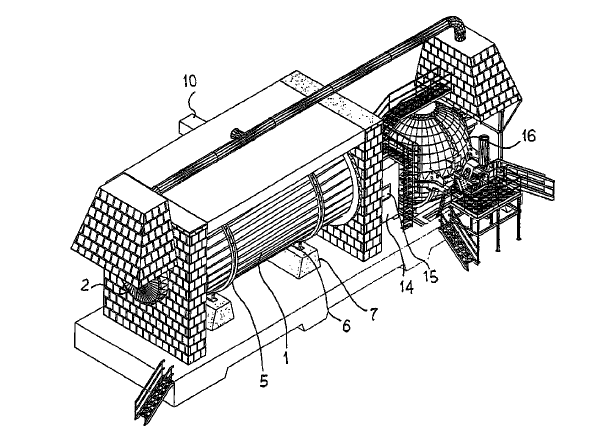
US7550028 — METHOD FOR RECYCLING ALUMINUM-LITHIUM-TYPE ALLOY SCRAP — Alcan Rhenalu (France) — The present invention is directed to a method for melting scrap of an aluminum alloy containing lithium. The steps include providing scrap containing aluminum-lithium-type alloys, preparing an initial liquid metal bed of a first composition in a smelting oven, loading the scrap onto the initial liquid metal bed so as to create a floating layer of the scrap with a controlled thickness at the surface of the liquid metal bed, partially melting the floating layer via contact with the metal bed so as to obtain a liquid metal bath having a second composition, and removing the liquid metal from the second composition of the liquid metal bath. The method has technical and economic advantages. It does not require investment in a particular installation and it requires minimal use of expensive expendable materials such as inert gas, because the formation of a floating layer having a controlled thickness makes it possible to effectively protect the surface of the liquid metal from oxidation.
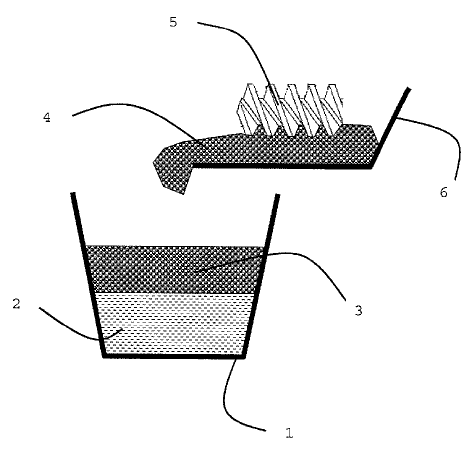
US6936089 — MOLTEN ALUMINUM ALLOY PROCESSING METHOD AND FLUX FOR MOLTEN ALUMINUM ALLOY PROCESSING — Kabushiki Kaisha Kobe Seiko Sho (Kobe Steel, Ltd.) (Japan) — A molten aluminum alloy processing method is intended use sludge produced by the zinc phosphate treatment of structures including those of aluminum alloys effectively as a flux for molten aluminum alloy processing. The flux contains 3 to 30% by mass fluorine-equivalent metal fluorides, 40 to 90% by mass metal phosphates (8 to 18% by mass P) and 50% by mass or below inorganic salts. The sum of contents of the inorganic salts and metal phosphates is 90% by mass or below.
